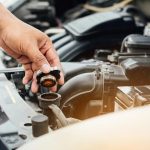
When piston damage occurs, the engine suffers. It can mean many problems and result in reduced vehicle performance. But how do you tell that engine pistons are faulty? Luckily, piston failure causes a number of symptoms. In many vehicles, a faulty engine part triggers a dashboard light (check engine light). That should be the first sign to make you suspect piston damage. Other symptoms are explained below. We categorized them into different piston parts.
Piston Damage Signs and Diagnosis
Piston Ring Failure
Piston rings seal the gap between the piston and cylinder, control the oil that lubricates the cylinder, and conduct away heat. If they wear out or break down, the results are always devastating. It can range from reduced engine power to increase exhaust emissions.
Damaged rings will show eroded material, increased piston and cylinder wall clearance, and visible axial and radial wear. That can cause what is known as “piston slap.” Piston slap is the noise caused by excessive rocking of the piston. It results from too much piston and cylinder clearance.
Worn piston rings also allow oil to leak into the combustion chamber and a lack of adequate piston lubrication. Combustion gases leak to the crankcase, too. This is often called piston blow by. It often leads to different engine problems.
Causes of piston ring damage
Faulty piston rings can be as a result of: incorrect installation, improper dimensions, fuel flooding, inadequate combustion of the fuel/air mixture, worn ring groove, abrasive particles in the oil, and tiny chips left after machining or reconditioning the engine.
Symptoms:
Symptoms that show you may be having faulty rings on the piston are:
- Excessive consumption of lubricating oil due to its leaking into the combustion chamber
- Reduced engine power as a result of loss of compression
- Thick, gray, bluish or white smoke coming out of the exhaust, caused by burning oil in the combustion chamber
- Loss of acceleration when the piston ring damage reaches a critical level
- An engine that overheats too quickly
Diagnosis:
To detect damage in piston rings, use a leak-down test. The test measures the amount of air leaking into the crankcase from the area above the piston. Damaged rings should be replaced to avoid damage to other piston parts and the whole engine.
To preserve the rings from damage, follow these rules: use the right installation process, the correct piston size, ensure piston ring fit when rebuilding the engine. Change oil on time to avoid abrasive particles from reaching the rings. Also, clean up the engine after you have milled it.
2. Piston Crown Damage
The piston head operates in a very hot environment. Sometimes, there is detonation in the combustion chamber or a valve that comes too close or even falls on the crown. These instances make the crown one of the most susceptible parts for piston damage. Being the floor of the combustion chamber, its damage can mean a poorly performing engine.
Causes of piston head damage
They include: installing the wrong piston type or a piston with incorrect dimensions, faulty cooling system, fuel flooding and wrong fuel grade, detonation, faulty cylinder head components, broken valves, carbon deposits.
Symptoms:
- Engine noise
- Engine misfires
- Reduced compression
- Too much blow-by
Diagnosis
A visual observation will reveal a hole or depression on piston head, scuffing, eroded material on the crown edges, and melted parts. In severe cases, you may have a cracked piston head. Replace pistons that show excessive crown damage. Ensure that you also establish the cause of this kind of piston damage, or risk experiencing the same with the new piston.
To protect the piston crown, use the correct fuel grade and type, ensure the right piston and correct piston dimensions, and take piston measurements when rebuilding the engine. Check for carbon deposits in the combustion chamber and hot spots on the piston head, too. Because cylinder head parts are a major cause of piston crown damage, ensure these are working correctly at all times.
3. Piston Skirt Damage
A piston skirt helps to balance the piston within the cylinder. It is usually coated with a low friction material to enable smooth piston operation. But the skirt can wear or deform as a result of many operating conditions. Worn piston skirts increase piston clearance, which then causes a myriad of problems.
Causes of worn or collapsed piston skirt
A damaged piston can be a result of incorrect piston (too small for the cylinder),excessive rocking of the piston, insufficient compression, fuel flood, bent connecting rod, excessive clearance at the conrod bearing, uneven or pitted cylinder walls, lack of lubrication. The photo below shows a scored piston, most probably due to lack of adequate lubrication.
Symptoms:
When piston damage involves the skirt, here are the signs that follow:
- Piston noise or piston slap (caused by the piston hitting the cylinder wall as a result of excessive rocking)
- Poor engine performance
- Piston skirt seizure in the cylinder
- Dry running damage
- Overheating of the engine
Diagnosis
A visual inspection of the piston skirt will show visible material erosion and collapsed or deformed parts. Upon measuring, you will find the piston clearance, to have increased. On starting the engine, there will be piston slap noise or what is called piston knock. Do these things to prevent piston damage at the skirt section:
Ensure correct piston size. Other piston parts such as rings, pin, connecting rod, and bearings should be in good condition always. Change pistons whose skirt section is worn or deformed. Damaged cylinders can be bored or sleeved to accommodate the piston correctly.

